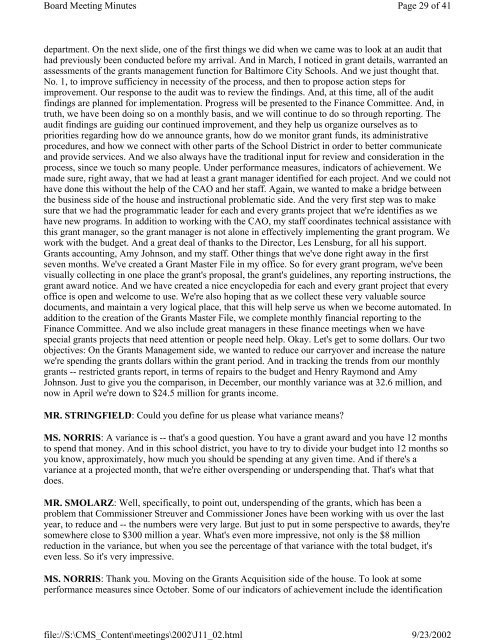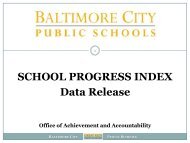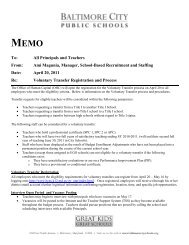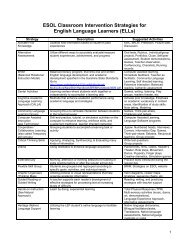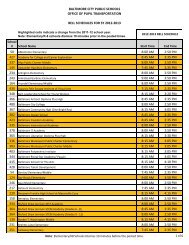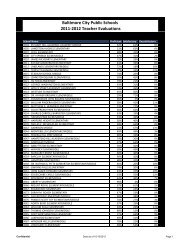June 11, 2002 - Baltimore City Public Schools
June 11, 2002 - Baltimore City Public Schools
June 11, 2002 - Baltimore City Public Schools
Create successful ePaper yourself
Turn your PDF publications into a flip-book with our unique Google optimized e-Paper software.
Board Meeting Minutes<br />
department. On the next slide, one of the first things we did when we came was to look at an audit that<br />
had previously been conducted before my arrival. And in March, I noticed in grant details, warranted an<br />
assessments of the grants management function for <strong>Baltimore</strong> <strong>City</strong> <strong>Schools</strong>. And we just thought that.<br />
No. 1, to improve sufficiency in necessity of the process, and then to propose action steps for<br />
improvement. Our response to the audit was to review the findings. And, at this time, all of the audit<br />
findings are planned for implementation. Progress will be presented to the Finance Committee. And, in<br />
truth, we have been doing so on a monthly basis, and we will continue to do so through reporting. The<br />
audit findings are guiding our continued improvement, and they help us organize ourselves as to<br />
priorities regarding how do we announce grants, how do we monitor grant funds, its administrative<br />
procedures, and how we connect with other parts of the School District in order to better communicate<br />
and provide services. And we also always have the traditional input for review and consideration in the<br />
process, since we touch so many people. Under performance measures, indicators of achievement. We<br />
made sure, right away, that we had at least a grant manager identified for each project. And we could not<br />
have done this without the help of the CAO and her staff. Again, we wanted to make a bridge between<br />
the business side of the house and instructional problematic side. And the very first step was to make<br />
sure that we had the programmatic leader for each and every grants project that we're identifies as we<br />
have new programs. In addition to working with the CAO, my staff coordinates technical assistance with<br />
this grant manager, so the grant manager is not alone in effectively implementing the grant program. We<br />
work with the budget. And a great deal of thanks to the Director, Les Lensburg, for all his support.<br />
Grants accounting, Amy Johnson, and my staff. Other things that we've done right away in the first<br />
seven months. We've created a Grant Master File in my office. So for every grant program, we've been<br />
visually collecting in one place the grant's proposal, the grant's guidelines, any reporting instructions, the<br />
grant award notice. And we have created a nice encyclopedia for each and every grant project that every<br />
office is open and welcome to use. We're also hoping that as we collect these very valuable source<br />
documents, and maintain a very logical place, that this will help serve us when we become automated. In<br />
addition to the creation of the Grants Master File, we complete monthly financial reporting to the<br />
Finance Committee. And we also include great managers in these finance meetings when we have<br />
special grants projects that need attention or people need help. Okay. Let's get to some dollars. Our two<br />
objectives: On the Grants Management side, we wanted to reduce our carryover and increase the nature<br />
we're spending the grants dollars within the grant period. And in tracking the trends from our monthly<br />
grants -- restricted grants report, in terms of repairs to the budget and Henry Raymond and Amy<br />
Johnson. Just to give you the comparison, in December, our monthly variance was at 32.6 million, and<br />
now in April we're down to $24.5 million for grants income.<br />
MR. STRINGFIELD: Could you define for us please what variance means?<br />
Page 29 of 41<br />
MS. NORRIS: A variance is -- that's a good question. You have a grant award and you have 12 months<br />
to spend that money. And in this school district, you have to try to divide your budget into 12 months so<br />
you know, approximately, how much you should be spending at any given time. And if there's a<br />
variance at a projected month, that we're either overspending or underspending that. That's what that<br />
does.<br />
MR. SMOLARZ: Well, specifically, to point out, underspending of the grants, which has been a<br />
problem that Commissioner Streuver and Commissioner Jones have been working with us over the last<br />
year, to reduce and -- the numbers were very large. But just to put in some perspective to awards, they're<br />
somewhere close to $300 million a year. What's even more impressive, not only is the $8 million<br />
reduction in the variance, but when you see the percentage of that variance with the total budget, it's<br />
even less. So it's very impressive.<br />
MS. NORRIS: Thank you. Moving on the Grants Acquisition side of the house. To look at some<br />
performance measures since October. Some of our indicators of achievement include the identification<br />
file://S:\CMS_Content\meetings\<strong>2002</strong>\J<strong>11</strong>_02.html<br />
9/23/<strong>2002</strong>


